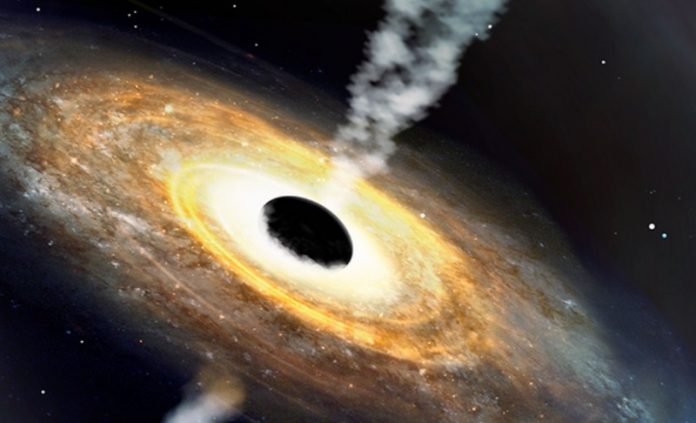
Astronomers have discovered the most massive quasar known in the early universe, containing a monster black hole with a mass equivalent to 1.5 billion suns.
Formally designated as J1007+2115, the newly discovered quasar is one of only two known from the same cosmological period.
Quasars are the most energetic objects in the universe, and since their discovery, astronomers have been keen to determine when they first appeared in our cosmic history.
In honor of its discovery via telescopes on Maunakea, a mountain revered in the Hawaiian culture, the quasar was given the Hawaiian name Pōniuāʻena, meaning “unseen spinning source of creation, surrounded with brilliance.”
It is the first quasar to receive an Indigenous name, which was created by 30 Hawaiian immersion school teachers during a workshop led by the A Hua He Inoa group, a Hawaiian naming program led by the ‘Imiloa Astronomy Center of Hawai’i.
According to current theory, quasars are powered by supermassive black holes.
As the black holes gobble up surrounding matter such as dust, gas or even entire stars, they emit tremendous amounts of energy, resulting in luminosities known to outshine entire galaxies.
The supermassive black hole powering Pōniuāʻena makes this quasar the most distant, and therefore earliest, object known in the universe to host a black hole exceeding 1 billion solar masses.
According to a new study documenting the quasar’s discovery, the light from Pōniuāʻena took 13.02 billion years to reach Earth — starting its journey just 700 million years after the Big Bang.
“It’s the earliest monster of this kind that we know of,” said Jinyi Yang, a postdoctoral research associate at the University of Arizona’s Steward Observatory and lead author of the study, which will be published in The Astrophysical Journal Letters.
“The time was too short for it to grow from a small black hole to the enormous size we see.”
The question of how such a massive black hole could materialize when the universe was still in its infancy has vexed astronomers and cosmologists for a long time, said co-author Xiaohui Fan, Regents’ Professor and associate head of the UArizona Department of Astronomy.
“This discovery presents the biggest challenge yet for the theory of black hole formation and growth in the early universe,” Fan said.
The notion that a black hole of Pōniuāʻenas proportions could have evolved from a much smaller black hole formed by the collapse of a single star in such a short time since the Big Bang is next to impossible, according to current cosmological models.
Instead, the study authors suggest that the quasar would have had to start out as a “seed” black hole already containing the equivalent mass of 10,000 suns as early as 100 million years after the Big Bang.
A look back at a young universe
Pōniuāʻena was discovered through a systematic search for the most distant quasars.
It began with the research team combing through large area surveys such as the DECaLS imaging survey, which uses the Dark Energy Camera on the Víctor M.
Blanco 4-meter Telescope located at the Cerro Tololo Inter-American Observatory in Chile, and the UHS imaging survey, which uses the Wide Field Camera on the UK Infra-Red Telescope, located at Maunakea.
The team uncovered a possible quasar in the data and, in 2019, observed it with telescopes including the Gemini North telescope and the W. M. Keck Observatory, both on Maunakea.
The Magellan telescope at the Las Campanas Observatory in Chile confirmed the existence of Pōniuāʻena.
“Observations with Gemini were critical for obtaining the high-quality near-infrared spectra that provided us with the measurement of the black hole’s astounding mass,” said co-author Feige Wang, a NASA Hubble Fellow at Steward Observatory.
The discovery of a quasar from the dawn of the cosmos provides researchers with a rare glimpse into a time when the universe was still young and very different from what we see today, the researchers said.
Current theory suggests that at the beginning of the universe, following the Big Bang, atoms were too distant from one another to interact and form stars and galaxies. The birth of stars and galaxies as we know them happened during the Epoch of Reionization, about 400 million years after the Big Bang.
“In the aftermath of the Big Bang, the universe was very cold, because there were no stars yet; no light,” Fan said. “It took about 300 to 400 million years for the first stars and galaxies to appear, and they began heating up the universe.”
Under the influence of heating, hydrogen molecules were stripped of electrons in a process known as ionization. This process lasted only a few hundred million years – a blink of an eye in the life of the universe – and is the subject of ongoing research.
The discovery of quasars like Pōniuāʻena, deep into the reionization epoch, is a big step towards understanding the process of reionization and the formation of early supermassive black holes and massive galaxies.
Pōniuāʻena has placed new and important constraints on the evolution of the matter between galaxies, known as the intergalactic medium, during the reionization epoch.
“This quasar looks like it was detected right at the mid-point of that period,” Fan said, “and the fact that we can observe these objects helps us refine what happened during that period.”
In 2018, the survey team announced the discovery of the most distant quasar found to date. Designated as J1342+0928, that object is 2 million years older than Pōniuāʻena – a rather insignificant difference by cosmic standards, according to Fan, who was involved in both discoveries, which were made using the international Gemini Observatory and Cerro Tololo Inter-American Observatory – both programs of the National Science Foundation’s National Optical-Infrared Astronomy Research Laboratory.
“The difference of 2 million light-years out of 13 billion makes that pretty close to a tie,” Fan said.
Written by Daniel Stolte.



